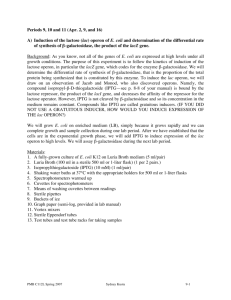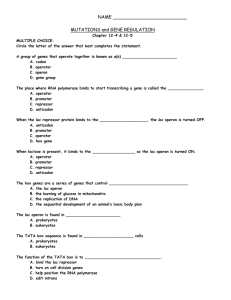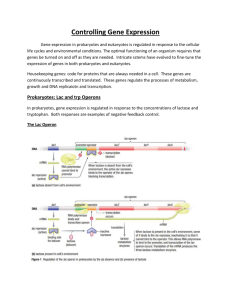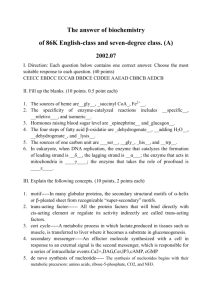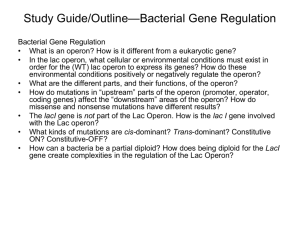Lab 7: Got milk?
advertisement
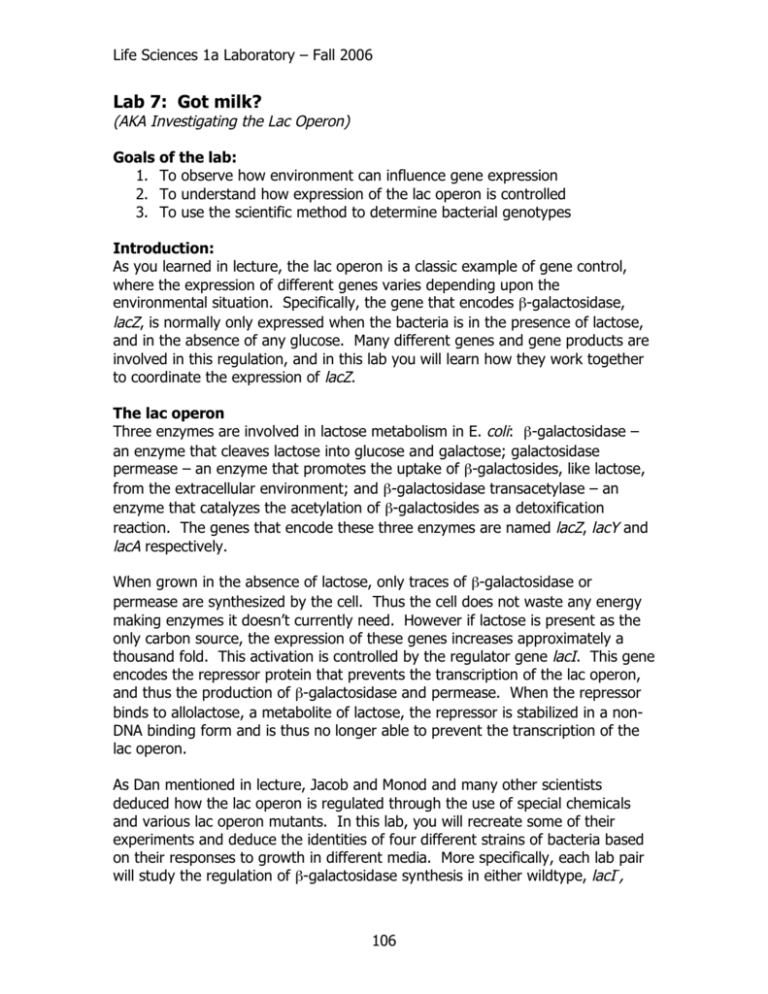
Life Sciences 1a Laboratory – Fall 2006 Lab 7: Got milk? (AKA Investigating the Lac Operon) Goals 1. 2. 3. of the lab: To observe how environment can influence gene expression To understand how expression of the lac operon is controlled To use the scientific method to determine bacterial genotypes Introduction: As you learned in lecture, the lac operon is a classic example of gene control, where the expression of different genes varies depending upon the environmental situation. Specifically, the gene that encodes β-galactosidase, lacZ, is normally only expressed when the bacteria is in the presence of lactose, and in the absence of any glucose. Many different genes and gene products are involved in this regulation, and in this lab you will learn how they work together to coordinate the expression of lacZ. The lac operon Three enzymes are involved in lactose metabolism in E. coli: β-galactosidase – an enzyme that cleaves lactose into glucose and galactose; galactosidase permease – an enzyme that promotes the uptake of β-galactosides, like lactose, from the extracellular environment; and β-galactosidase transacetylase – an enzyme that catalyzes the acetylation of β-galactosides as a detoxification reaction. The genes that encode these three enzymes are named lacZ, lacY and lacA respectively. When grown in the absence of lactose, only traces of β-galactosidase or permease are synthesized by the cell. Thus the cell does not waste any energy making enzymes it doesn’t currently need. However if lactose is present as the only carbon source, the expression of these genes increases approximately a thousand fold. This activation is controlled by the regulator gene lacI. This gene encodes the repressor protein that prevents the transcription of the lac operon, and thus the production of β-galactosidase and permease. When the repressor binds to allolactose, a metabolite of lactose, the repressor is stabilized in a nonDNA binding form and is thus no longer able to prevent the transcription of the lac operon. As Dan mentioned in lecture, Jacob and Monod and many other scientists deduced how the lac operon is regulated through the use of special chemicals and various lac operon mutants. In this lab, you will recreate some of their experiments and deduce the identities of four different strains of bacteria based on their responses to growth in different media. More specifically, each lab pair will study the regulation of β-galactosidase synthesis in either wildtype, lacI-, 106 Life Sciences 1a Laboratory – Fall 2006 lacZ-, or lacY- E. coli. You will measure β-galactosidase activity by following the hydrolysis of the indicator ONPG which will turn yellow when cleaved by the enzyme. Protocol: Reagents Medium A B C D Color Code Red Green Yellow Blue Ingredients Glycerol (2 x 10-3 M) Lactose (2 x 10-2 M) Glycerol (2 x 10-3 M); TMG (2 x 10-3 M) Lactose (2 x 10-2 M); glucose (4 x 10-2 M) Each lab pair will examine 1 of 4 bacteria strains. They will then record their results with the rest of the lab to determine the identities of each strain. 1. 2. 3. 4. 5. Collect a set of 4 tubes containing 4 different media Label each tube with your initials and the bacteria strain To each tube, add 5 drops of bacteria Place your tubes in the shaking incubator, and shake at 37° C for 1 hr After 1 hr, take your tubes to the hood and add 1 drop of toluene to each tube. Return the tubes to the incubator and shake for another 10 minutes maximum. a. The toluene makes the bacterial cell wall permeable to ONPG 6. After 10 minutes, to each tube add 2 drops of ONPG 7. Return the tubes to the incubator and continue shaking as the color develops 8. Check your tubes periodically and record the time and the observed color changes (if any) 9. After your reaction is complete (or your TF tells you it is), tally your results on the board in the front of the classroom. 10. Record the results from all of your lab mates, both in your section and the other sections in the same time slot. 107 Life Sciences 1a Laboratory – Fall 2006 Questions: 1. Attach a table with your entire labs (all sections belonging in a given time slot) results, and explain them. a. What strain did your lab pair test? b. What were the results for your strain? c. Were the results of every other lab pair testing the same strain identical? Why or why not? d. Were the results for the other strains consistent between different groups? e. What is the identity of each strain? Explain. 2. In this lab the bacteria in the dropper bottles had been prepared in media containing glycerol as the carbon source. Why did we have to incubate the bacteria for an hour in the new media? 3. You have observed that different bacteria strains grown on different media exhibit different gene expression patterns. Based on your observations, and your knowledge of the lac operon, write a hypothesis explaining how lacZ expression is regulated. 4. Bacteria grown solely on lactose will grow, as will bacteria grown only on ONPG. However cells grown solely on TMG will not grow, and will instead eventually die. Based on the structures provided below, why are cells capable of growing on ONPG and lactose, but not TMG alone? HO O +O S HO O O O HO HO OH OH thiomethyl-beta-D-galactopyranoside HO O N O HO HO O OHO OH OH OH OH OH Ortho-nitrophenyl-ß-galactoside OH lactose 5. Would you have been able to conclusively determine the identities of all 4 strains if media C were not used in the testing of any of the 4 strains? Explain. 108 Life Sciences 1a Laboratory – Fall 2006 6. In this lab, 3 of the 4 media contained either an inducer or repressor of lac operon expression. Which compounds are inducers and which are repressors? Additionally, based on the results of media A, what is the default state of lac operon expression in wildtype cells (induced or repressed). Explain. 7. As Dan mentioned in lecture, the lac repressor is able to work in trans. Explain what this means, and how it differs from a repressor that works in cis. 8. Based on your understanding of the lac operon, what do you expect would have been the results of this experiment had cells from the different strains been fused together? Explain your reasoning. Media A Glycerol Media B Lactose Media C Glycerol, TMG Media D Lactose, Glucose wt/lacIwt/lacZwt/lacYlacI-/lacZlacI-/lacYlacZ-/lacY- 9. Gene control is essential in embryonic development. It is known that skin cells and nerve cells develop from the same group of embryonic cells. A gene called noggin is essential in regulating the fate of these cells. The genes expressed in cells exposed to noggin protein are vastly different from those not exposed to the protein. If noggin is over-expressed in an embryo, excess amounts of nerve cells are made and less skin is produced. However if noggin is deleted (removed from the genome) the nervous system is underdeveloped and excess skin is formed. Based on this information, do you believe that noggin induces a nerve cell fate by activating a nervous cell specific pathway? Briefly explain your logic. 109
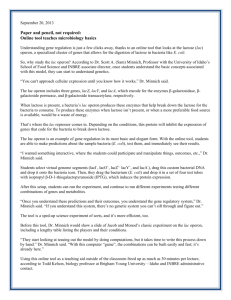

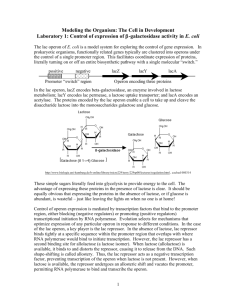
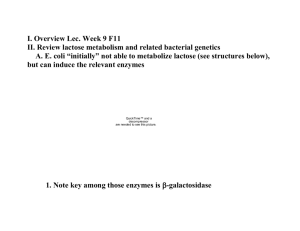
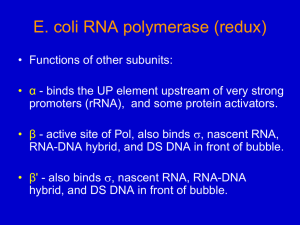
![Lac Operon AP Biology PhET Simulation[1]](http://s3.studylib.net/store/data/006805976_1-a15f6d5ce2299a278136113aece5b534-300x300.png)
